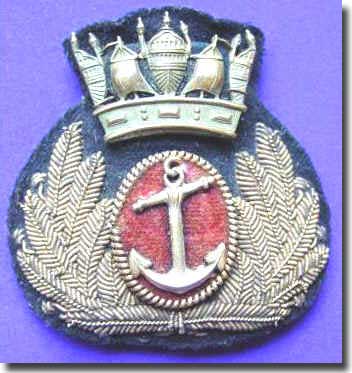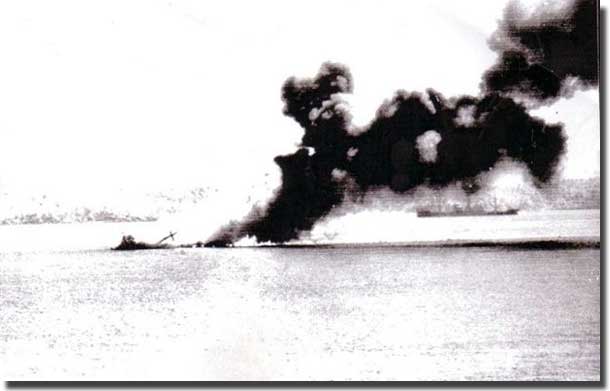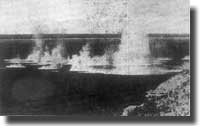Merchant Marine Officers WW2 Cap badge
 |
Introduction.
Some 60 different Shipping Companies have owned and operated Australian ships over the long period from the 1880's to the 1950's. Some were but small companies and maybe operated just one vessel for their own purposes, but in the main, ships carried both passengers and cargo from port to port on the Australian coast.
Sadly today, the Australian Merchant Fleet has but something like 45 ships operating on our vast coastline.
The war years of 1939-1945.
During those turbulent days, 76 merchant ships were lost in Australian waters claimed by mines, Submarine torpedoes, shelling or bombing. Of these 76 ships, 29 were Australian.
Australian Merchant Sailors lost.
In the Australian ships sunk off our coastline, 349 Australian seamen died, some became Prisoners of War, and of these, 37 died in captivity.
Defensively Equipped Merchant Ships. ( D.E.M.S. )
The Royal Australian Navy trained and supplied gunners to man the Defencively Equipped Merchant Ships during WW2, these gunners operated in a similar manner to the United States Armed Guard. 38 of these D.E.M.S's gunners were to be killed in WW2.
Merchant Marine casualities in WW2.
Over WW2, the high figure of 6.5% of all Merchant Navy personnel perished as a result of their war service, a greater % than any other of the Armed services.
When the Allied forces invaded the Philipppines at Leyte to retake them from the Japanese in October 1944, and then in Northern Luzon, at Lingayen Gurf, in January of 1945, the Merchant Navy suffered more casualities than did all the other service combined.
Let us look at just three of the older Australian Shipping Companies.
Burns Philip.
Two brothers, James and John Burns arived in Brisbane, Queensland in December 1862, and in 1865 set up a store at the Gympie goldfields. Now on to the mid 1870's, James Burns and Robert Philip were partners at Townsville with shipping links in Brisbane and Sydney for inter island and overseas trade. After 1876, James Burns worked in Sydney and Burns-Phillip were incorporated in 1883. It prospered, trading in the South West Pacific, and over time, operated 38 ships out of Australia ports.
World War 1.
In WW1, their Matunga was plying the route between Brisbane and Rabaul, to be captured by the German Armed Merchant Raider Wolf on the 6th. of August 1917, they sailed in company for about a week, then Matunga was sunk after taking off all her crew and passengers. They went of to Europe in the Raider to become Prisoners of War. For the residents of Rabaul this sinking was unfortunate, as Matunga was carrying their supply of Christmas alcohol, destined not to arrive that year.
World War 2.
In WW2, the new BP ship Bulolo, just completed in 1939 in UK, was requisitioned for use by the Royal Navy. Burns Phiip lost three mainline ships, Mucdhui, sunk in Port Moresby Harbour with the loss of 10 crew, Neptune, sunk in Darwin Harbour by Japanese aircraft with 45 killed, and Tulagi, sunk in the Indian Ocean, losing 47 crew members.
Several of their inter island ships also came to grief. Burns Philip Navigators had accumulated a wealth of local knowledge around and about the Pacific Islands served by the company's ships, and their Officers were able to provide invaluable assistance to the Allies as we marched slowly up that sea road towards our final destination in Japan.

MV Macdhui burning and sinking in Port Moresby Harbour
after two days of bombing by Japanese aircraft
Adelaide Steamship Company Limited.
This company was floated in 1875.
WW1.
In WW1, their ship Grantala supported the Expeditionary Force landing it in Rabaul. Willochra, Wardella and Warilda were all requisitioned as Troopships.
WW2.
The company entered WW2 owning some 30 ships, and Manoora, in 1939 became an Armed Merchant Cruiser, whilst Manunda was turned into a hospital ship in 1940. Morialtu built in UK, in 1940 went to the British Ministry of War Transport to work as a Trooper, and not be returned to the Company until 1947.
In 1941, Terka, Toorie, and Tolga all served the Royal Australian Navy as Auxiliary vessels, and Bungaree served the Navy as a minelayer.
The United States Small Ships Command in November 1942 took control of Wortana, Noora, Muleva, and Katoora.
Three coastal steamers were requisitioned by the RAN, Noora, as an Examination vessel, Kooraka, and Yandra as Mine Sweepers.
In 1943, Manoora gave up her AMC role to be converted to a Landing Ship Infantry, and she participated in a series of Island hopping landings, and in 1945 at war's end transported Aussie troops back home from both Asia and the Pacific Islands. It was 1949 before her owners had her back in service.
Melbourne Steam.
Founded in 1895. The company had 5 ships plying the east, south and west coasts of Australia. WW2.
When war came, Duntroon was soon converted to a Troopship, and on a dark, stormy night on her way to Port Phillip Heads, on the 20th. of November 1940, she ran down the 223 ton Minesweeper, HMAS Goorangi, chopping her in two, and killing all 23 of her crew. She trooped to the Pacific Islands, and at war's end she carried home Australian Prisoners of War who had been held by the Japanese. In the following years the ship supported the British Forces occupying Japan, not returning to her owners until 1949.
Bruno Reymond, Burns Philip Deck Officer.
Born in the Gilbert and Ellice Islands of German and Gilbertese parents he had served as First Mate in Mullama, and as Second Mate in Tulagi. In July of 1942, Bruno joined the Royal Australian Naval Reserve ( Seagoing ) as a Lieutenant, and went off to Pearl Harbor to serve in the US Pacific Fleet as a Pilot in a Naval rather than in a Flying capacity, and assisted in the landing preparations for Tarawa.
As he spoke Malay, he joined the Australian Z Force, the group that effectively raided Singapore Harbour in October 1943, known as Operation Jaywick.
For the Rimau Operation in October 1944, Bruno was named as the Navigator, and he sailed out of Fremantle in the British Submarine Porpoise, on the 11th. of September, to reach Rhio Archipeligo two weeks later. The raiding group in a local junk Mustika were only 20 kilometres out of Singapore when a Japanese Patrol boat challenged them, in the fight the junk was scuttled, and of the 23 in the party, 11 were captured, and the rest killed or drowned.
Bruno Reymond at age 31 was killed on Pelapis Island on the 23rd. of December 1944.
Conclusion.
General MacArthur's tribute to the Merchant Navy Service of the Allied Nations in the Pacific War.
"They have brought us our life blood, and have paid for it with some of their own. I saw them bombed in New Guinea and the Philippine's ports, when it was humanly possible, when their ships were not blown out from under them by bombs or torpedoes, they delivered their cargoes to us who needed them so badly. In war it is performance that counts."
The war, both in the European and Pacific theatres could not have been won without the bravery, dedication and service provided by the Merchant Marine, the Australian arm of this magnificent group of unsung heroes paid it part in earning our final victory.





